RN to BSN Nursing: Applying Leininger's and Watson's Theories
VerifiedAdded on 2023/01/19
|9
|2282
|68
Case Study
AI Summary
This assignment presents two case studies analyzed through the lenses of Leininger's Culture Care Theory and Watson's Transpersonal Caring Theory. The first case study focuses on Mrs. Franklin-Jones, a patient from Jamaica, and explores how Nurse Hernandez should consider cultural factors when planning her discharge, emphasizing culturally congruent care and the importance of understanding the patient's beliefs and food habits. The analysis includes a discussion of the strengths and limitations of Leininger's theory. The second case study delves into Watson's theory, discussing the assumptions of the transpersonal caring relationship, the nurse's role in creating a healing environment, and how love, as defined by Watson, is evident in caring moments. It also explores how nurses can creatively use themselves to foster healing and examines the strengths and limitations of Watson's theory, highlighting the importance of nurse-patient communication and the potential ambiguities in implementation. Desklib provides a platform for students to access similar solved assignments and study tools.
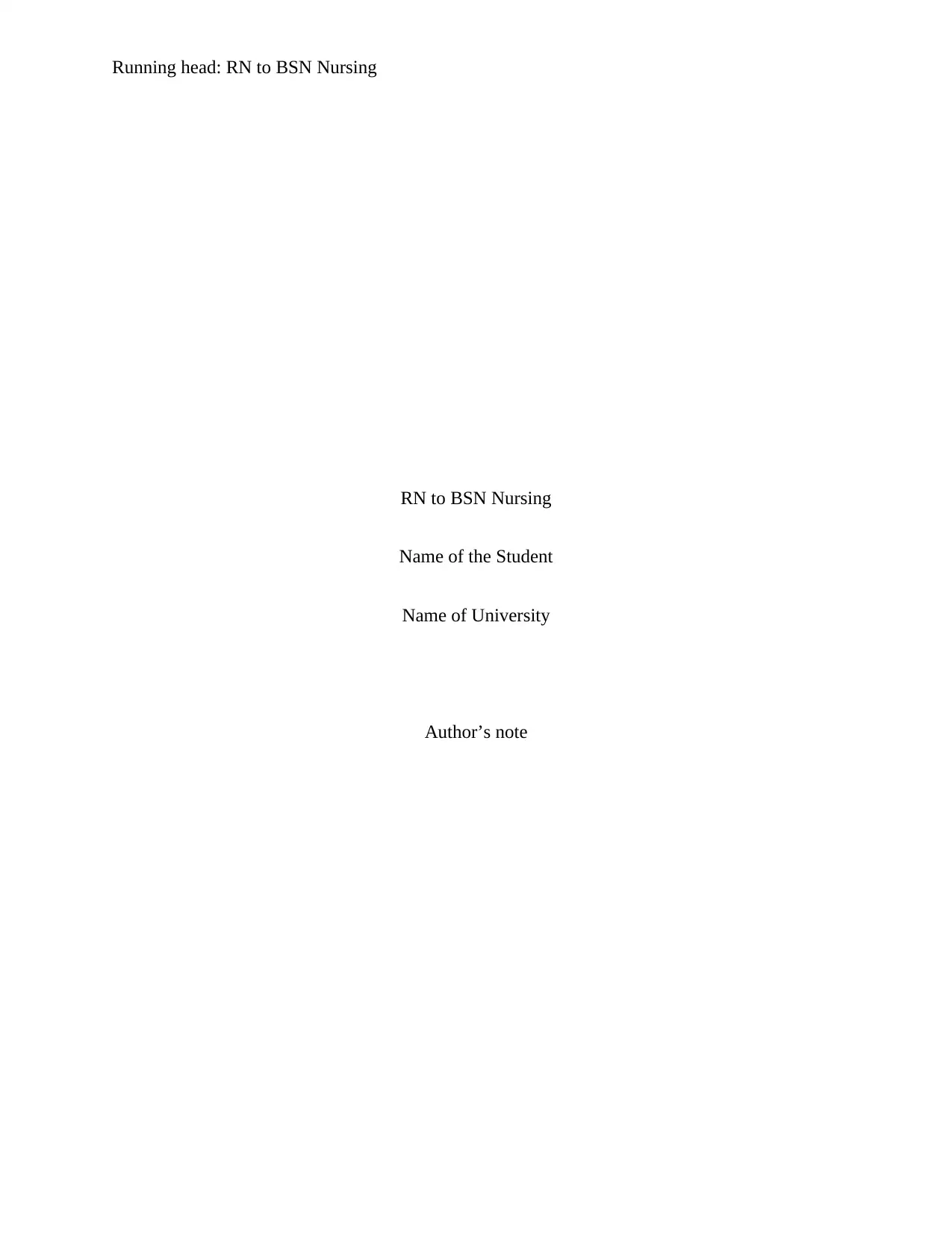
Running head: RN to BSN Nursing
RN to BSN Nursing
Name of the Student
Name of University
Author’s note
RN to BSN Nursing
Name of the Student
Name of University
Author’s note
Paraphrase This Document
Need a fresh take? Get an instant paraphrase of this document with our AI Paraphraser
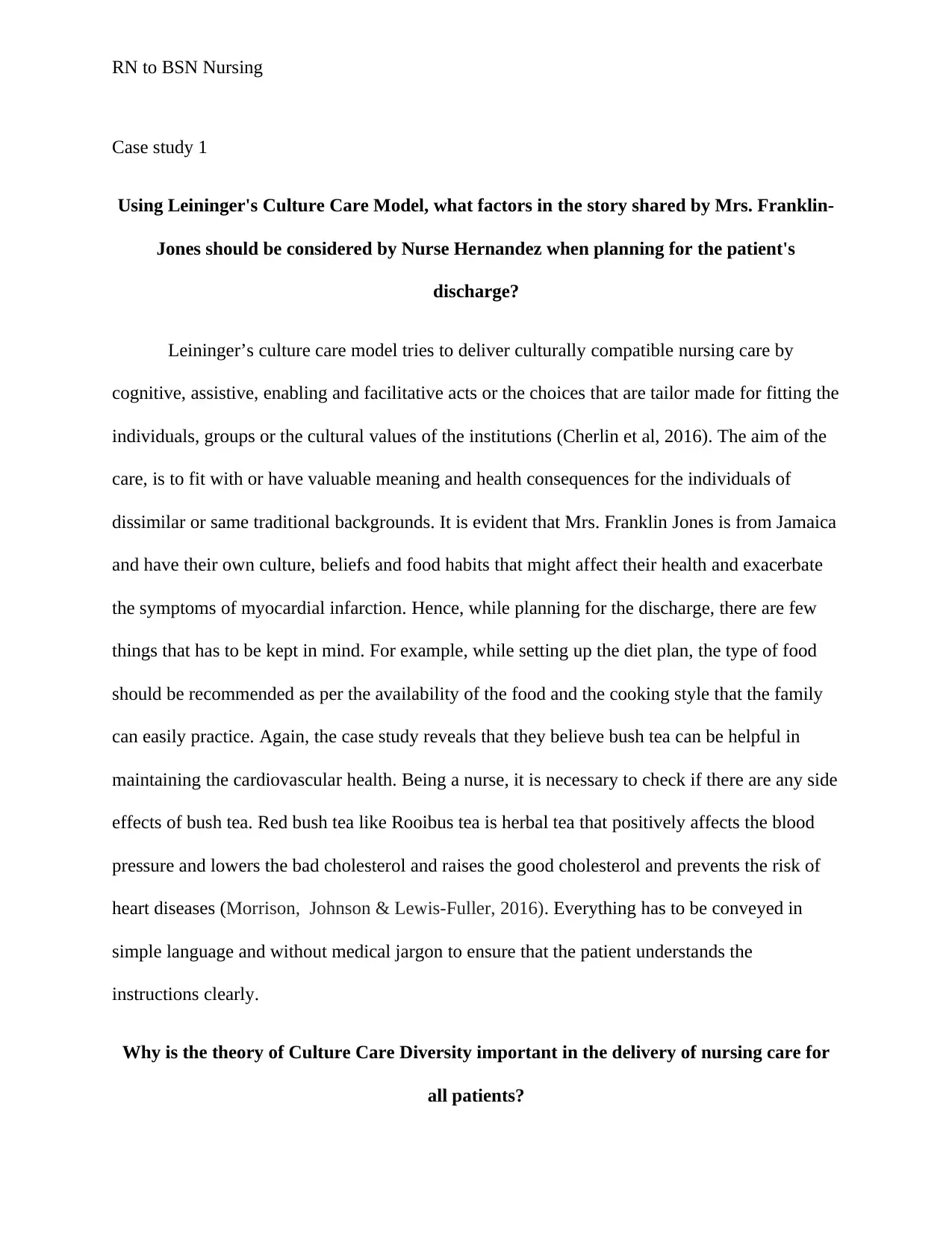
RN to BSN Nursing
Case study 1
Using Leininger's Culture Care Model, what factors in the story shared by Mrs. Franklin-
Jones should be considered by Nurse Hernandez when planning for the patient's
discharge?
Leininger’s culture care model tries to deliver culturally compatible nursing care by
cognitive, assistive, enabling and facilitative acts or the choices that are tailor made for fitting the
individuals, groups or the cultural values of the institutions (Cherlin et al, 2016). The aim of the
care, is to fit with or have valuable meaning and health consequences for the individuals of
dissimilar or same traditional backgrounds. It is evident that Mrs. Franklin Jones is from Jamaica
and have their own culture, beliefs and food habits that might affect their health and exacerbate
the symptoms of myocardial infarction. Hence, while planning for the discharge, there are few
things that has to be kept in mind. For example, while setting up the diet plan, the type of food
should be recommended as per the availability of the food and the cooking style that the family
can easily practice. Again, the case study reveals that they believe bush tea can be helpful in
maintaining the cardiovascular health. Being a nurse, it is necessary to check if there are any side
effects of bush tea. Red bush tea like Rooibus tea is herbal tea that positively affects the blood
pressure and lowers the bad cholesterol and raises the good cholesterol and prevents the risk of
heart diseases (Morrison, Johnson & Lewis-Fuller, 2016). Everything has to be conveyed in
simple language and without medical jargon to ensure that the patient understands the
instructions clearly.
Why is the theory of Culture Care Diversity important in the delivery of nursing care for
all patients?
Case study 1
Using Leininger's Culture Care Model, what factors in the story shared by Mrs. Franklin-
Jones should be considered by Nurse Hernandez when planning for the patient's
discharge?
Leininger’s culture care model tries to deliver culturally compatible nursing care by
cognitive, assistive, enabling and facilitative acts or the choices that are tailor made for fitting the
individuals, groups or the cultural values of the institutions (Cherlin et al, 2016). The aim of the
care, is to fit with or have valuable meaning and health consequences for the individuals of
dissimilar or same traditional backgrounds. It is evident that Mrs. Franklin Jones is from Jamaica
and have their own culture, beliefs and food habits that might affect their health and exacerbate
the symptoms of myocardial infarction. Hence, while planning for the discharge, there are few
things that has to be kept in mind. For example, while setting up the diet plan, the type of food
should be recommended as per the availability of the food and the cooking style that the family
can easily practice. Again, the case study reveals that they believe bush tea can be helpful in
maintaining the cardiovascular health. Being a nurse, it is necessary to check if there are any side
effects of bush tea. Red bush tea like Rooibus tea is herbal tea that positively affects the blood
pressure and lowers the bad cholesterol and raises the good cholesterol and prevents the risk of
heart diseases (Morrison, Johnson & Lewis-Fuller, 2016). Everything has to be conveyed in
simple language and without medical jargon to ensure that the patient understands the
instructions clearly.
Why is the theory of Culture Care Diversity important in the delivery of nursing care for
all patients?
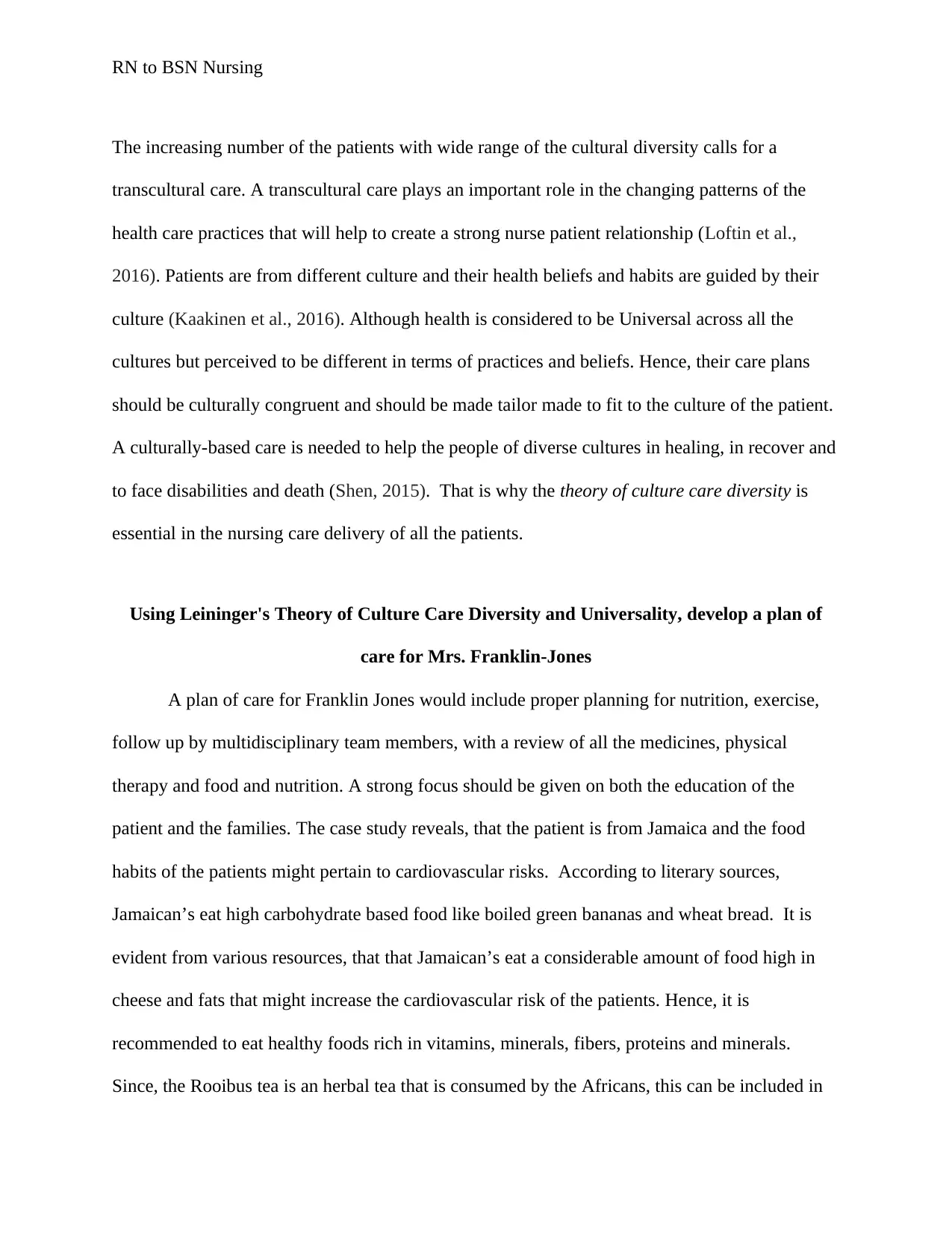
RN to BSN Nursing
The increasing number of the patients with wide range of the cultural diversity calls for a
transcultural care. A transcultural care plays an important role in the changing patterns of the
health care practices that will help to create a strong nurse patient relationship (Loftin et al.,
2016). Patients are from different culture and their health beliefs and habits are guided by their
culture (Kaakinen et al., 2016). Although health is considered to be Universal across all the
cultures but perceived to be different in terms of practices and beliefs. Hence, their care plans
should be culturally congruent and should be made tailor made to fit to the culture of the patient.
A culturally-based care is needed to help the people of diverse cultures in healing, in recover and
to face disabilities and death (Shen, 2015). That is why the theory of culture care diversity is
essential in the nursing care delivery of all the patients.
Using Leininger's Theory of Culture Care Diversity and Universality, develop a plan of
care for Mrs. Franklin-Jones
A plan of care for Franklin Jones would include proper planning for nutrition, exercise,
follow up by multidisciplinary team members, with a review of all the medicines, physical
therapy and food and nutrition. A strong focus should be given on both the education of the
patient and the families. The case study reveals, that the patient is from Jamaica and the food
habits of the patients might pertain to cardiovascular risks. According to literary sources,
Jamaican’s eat high carbohydrate based food like boiled green bananas and wheat bread. It is
evident from various resources, that that Jamaican’s eat a considerable amount of food high in
cheese and fats that might increase the cardiovascular risk of the patients. Hence, it is
recommended to eat healthy foods rich in vitamins, minerals, fibers, proteins and minerals.
Since, the Rooibus tea is an herbal tea that is consumed by the Africans, this can be included in
The increasing number of the patients with wide range of the cultural diversity calls for a
transcultural care. A transcultural care plays an important role in the changing patterns of the
health care practices that will help to create a strong nurse patient relationship (Loftin et al.,
2016). Patients are from different culture and their health beliefs and habits are guided by their
culture (Kaakinen et al., 2016). Although health is considered to be Universal across all the
cultures but perceived to be different in terms of practices and beliefs. Hence, their care plans
should be culturally congruent and should be made tailor made to fit to the culture of the patient.
A culturally-based care is needed to help the people of diverse cultures in healing, in recover and
to face disabilities and death (Shen, 2015). That is why the theory of culture care diversity is
essential in the nursing care delivery of all the patients.
Using Leininger's Theory of Culture Care Diversity and Universality, develop a plan of
care for Mrs. Franklin-Jones
A plan of care for Franklin Jones would include proper planning for nutrition, exercise,
follow up by multidisciplinary team members, with a review of all the medicines, physical
therapy and food and nutrition. A strong focus should be given on both the education of the
patient and the families. The case study reveals, that the patient is from Jamaica and the food
habits of the patients might pertain to cardiovascular risks. According to literary sources,
Jamaican’s eat high carbohydrate based food like boiled green bananas and wheat bread. It is
evident from various resources, that that Jamaican’s eat a considerable amount of food high in
cheese and fats that might increase the cardiovascular risk of the patients. Hence, it is
recommended to eat healthy foods rich in vitamins, minerals, fibers, proteins and minerals.
Since, the Rooibus tea is an herbal tea that is consumed by the Africans, this can be included in
⊘ This is a preview!⊘
Do you want full access?
Subscribe today to unlock all pages.

Trusted by 1+ million students worldwide
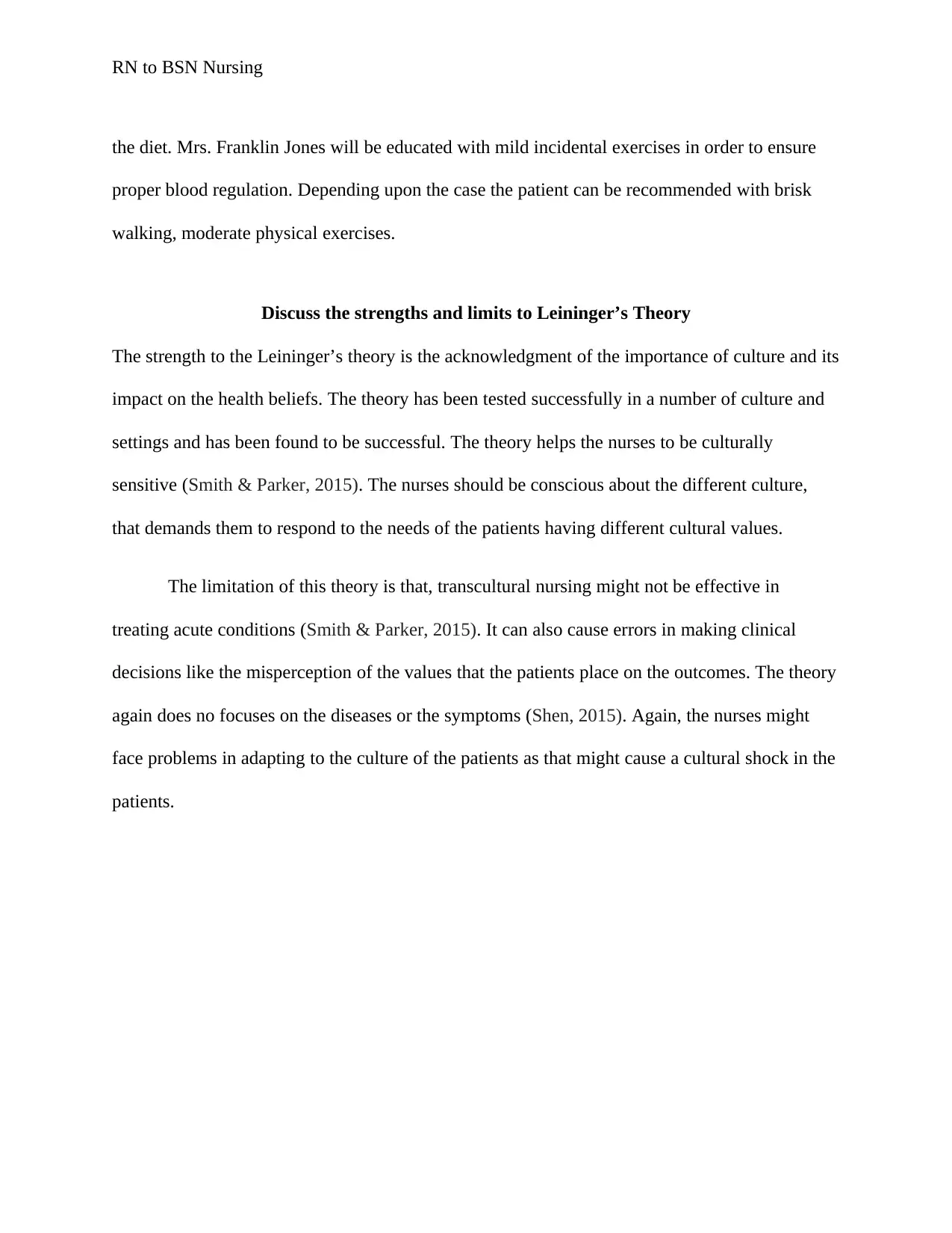
RN to BSN Nursing
the diet. Mrs. Franklin Jones will be educated with mild incidental exercises in order to ensure
proper blood regulation. Depending upon the case the patient can be recommended with brisk
walking, moderate physical exercises.
Discuss the strengths and limits to Leininger’s Theory
The strength to the Leininger’s theory is the acknowledgment of the importance of culture and its
impact on the health beliefs. The theory has been tested successfully in a number of culture and
settings and has been found to be successful. The theory helps the nurses to be culturally
sensitive (Smith & Parker, 2015). The nurses should be conscious about the different culture,
that demands them to respond to the needs of the patients having different cultural values.
The limitation of this theory is that, transcultural nursing might not be effective in
treating acute conditions (Smith & Parker, 2015). It can also cause errors in making clinical
decisions like the misperception of the values that the patients place on the outcomes. The theory
again does no focuses on the diseases or the symptoms (Shen, 2015). Again, the nurses might
face problems in adapting to the culture of the patients as that might cause a cultural shock in the
patients.
the diet. Mrs. Franklin Jones will be educated with mild incidental exercises in order to ensure
proper blood regulation. Depending upon the case the patient can be recommended with brisk
walking, moderate physical exercises.
Discuss the strengths and limits to Leininger’s Theory
The strength to the Leininger’s theory is the acknowledgment of the importance of culture and its
impact on the health beliefs. The theory has been tested successfully in a number of culture and
settings and has been found to be successful. The theory helps the nurses to be culturally
sensitive (Smith & Parker, 2015). The nurses should be conscious about the different culture,
that demands them to respond to the needs of the patients having different cultural values.
The limitation of this theory is that, transcultural nursing might not be effective in
treating acute conditions (Smith & Parker, 2015). It can also cause errors in making clinical
decisions like the misperception of the values that the patients place on the outcomes. The theory
again does no focuses on the diseases or the symptoms (Shen, 2015). Again, the nurses might
face problems in adapting to the culture of the patients as that might cause a cultural shock in the
patients.
Paraphrase This Document
Need a fresh take? Get an instant paraphrase of this document with our AI Paraphraser
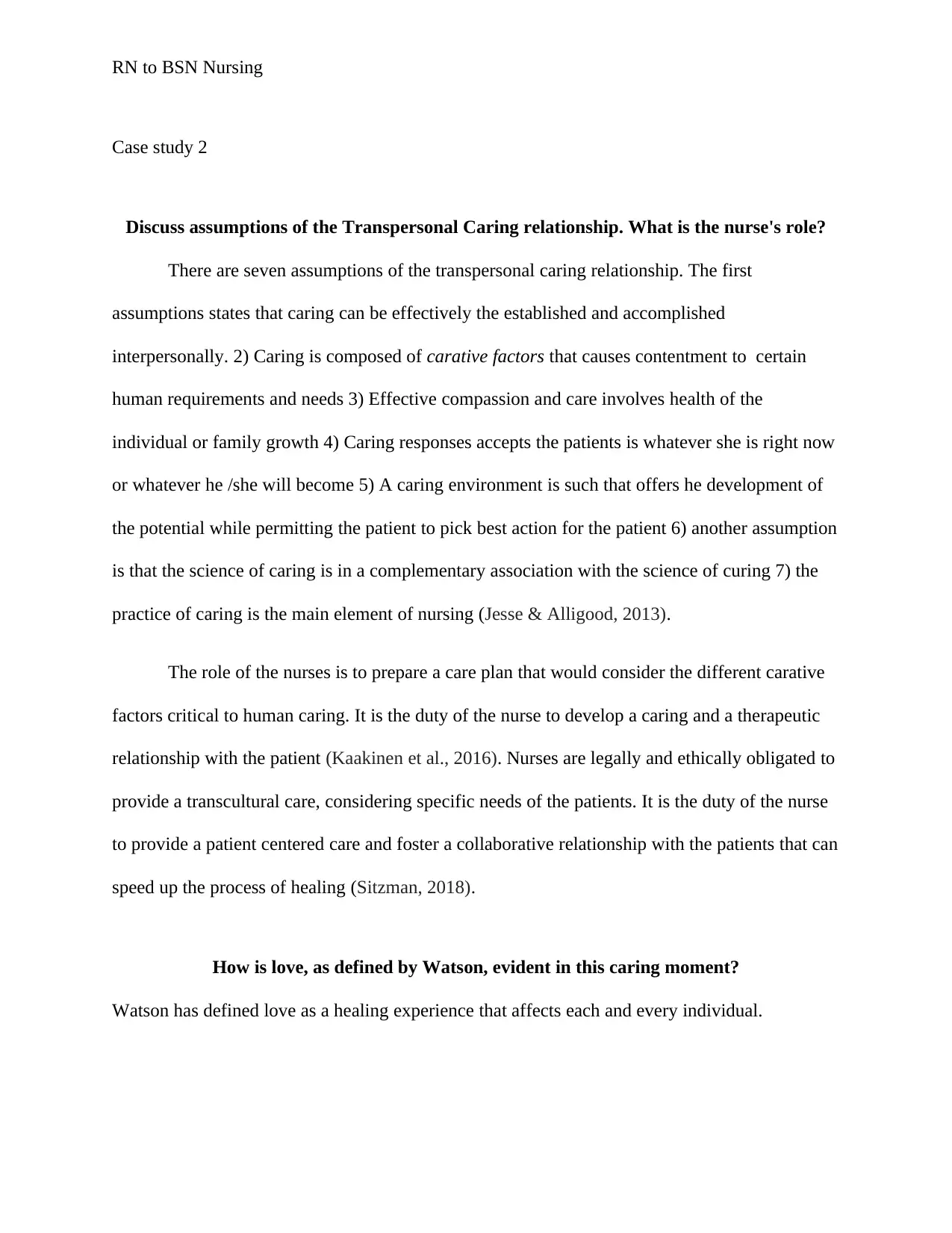
RN to BSN Nursing
Case study 2
Discuss assumptions of the Transpersonal Caring relationship. What is the nurse's role?
There are seven assumptions of the transpersonal caring relationship. The first
assumptions states that caring can be effectively the established and accomplished
interpersonally. 2) Caring is composed of carative factors that causes contentment to certain
human requirements and needs 3) Effective compassion and care involves health of the
individual or family growth 4) Caring responses accepts the patients is whatever she is right now
or whatever he /she will become 5) A caring environment is such that offers he development of
the potential while permitting the patient to pick best action for the patient 6) another assumption
is that the science of caring is in a complementary association with the science of curing 7) the
practice of caring is the main element of nursing (Jesse & Alligood, 2013).
The role of the nurses is to prepare a care plan that would consider the different carative
factors critical to human caring. It is the duty of the nurse to develop a caring and a therapeutic
relationship with the patient (Kaakinen et al., 2016). Nurses are legally and ethically obligated to
provide a transcultural care, considering specific needs of the patients. It is the duty of the nurse
to provide a patient centered care and foster a collaborative relationship with the patients that can
speed up the process of healing (Sitzman, 2018).
How is love, as defined by Watson, evident in this caring moment?
Watson has defined love as a healing experience that affects each and every individual.
Case study 2
Discuss assumptions of the Transpersonal Caring relationship. What is the nurse's role?
There are seven assumptions of the transpersonal caring relationship. The first
assumptions states that caring can be effectively the established and accomplished
interpersonally. 2) Caring is composed of carative factors that causes contentment to certain
human requirements and needs 3) Effective compassion and care involves health of the
individual or family growth 4) Caring responses accepts the patients is whatever she is right now
or whatever he /she will become 5) A caring environment is such that offers he development of
the potential while permitting the patient to pick best action for the patient 6) another assumption
is that the science of caring is in a complementary association with the science of curing 7) the
practice of caring is the main element of nursing (Jesse & Alligood, 2013).
The role of the nurses is to prepare a care plan that would consider the different carative
factors critical to human caring. It is the duty of the nurse to develop a caring and a therapeutic
relationship with the patient (Kaakinen et al., 2016). Nurses are legally and ethically obligated to
provide a transcultural care, considering specific needs of the patients. It is the duty of the nurse
to provide a patient centered care and foster a collaborative relationship with the patients that can
speed up the process of healing (Sitzman, 2018).
How is love, as defined by Watson, evident in this caring moment?
Watson has defined love as a healing experience that affects each and every individual.
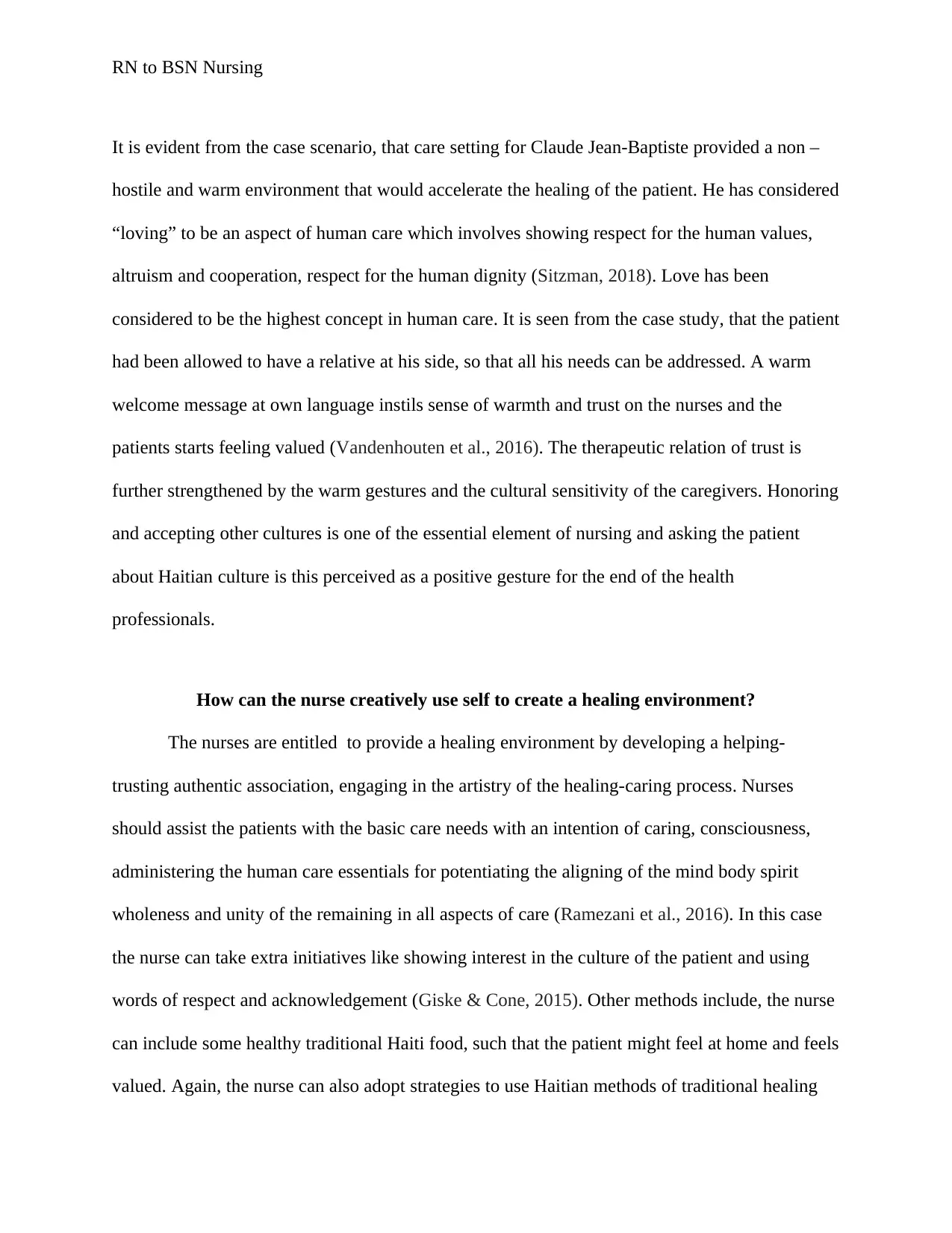
RN to BSN Nursing
It is evident from the case scenario, that care setting for Claude Jean-Baptiste provided a non –
hostile and warm environment that would accelerate the healing of the patient. He has considered
“loving” to be an aspect of human care which involves showing respect for the human values,
altruism and cooperation, respect for the human dignity (Sitzman, 2018). Love has been
considered to be the highest concept in human care. It is seen from the case study, that the patient
had been allowed to have a relative at his side, so that all his needs can be addressed. A warm
welcome message at own language instils sense of warmth and trust on the nurses and the
patients starts feeling valued (Vandenhouten et al., 2016). The therapeutic relation of trust is
further strengthened by the warm gestures and the cultural sensitivity of the caregivers. Honoring
and accepting other cultures is one of the essential element of nursing and asking the patient
about Haitian culture is this perceived as a positive gesture for the end of the health
professionals.
How can the nurse creatively use self to create a healing environment?
The nurses are entitled to provide a healing environment by developing a helping-
trusting authentic association, engaging in the artistry of the healing-caring process. Nurses
should assist the patients with the basic care needs with an intention of caring, consciousness,
administering the human care essentials for potentiating the aligning of the mind body spirit
wholeness and unity of the remaining in all aspects of care (Ramezani et al., 2016). In this case
the nurse can take extra initiatives like showing interest in the culture of the patient and using
words of respect and acknowledgement (Giske & Cone, 2015). Other methods include, the nurse
can include some healthy traditional Haiti food, such that the patient might feel at home and feels
valued. Again, the nurse can also adopt strategies to use Haitian methods of traditional healing
It is evident from the case scenario, that care setting for Claude Jean-Baptiste provided a non –
hostile and warm environment that would accelerate the healing of the patient. He has considered
“loving” to be an aspect of human care which involves showing respect for the human values,
altruism and cooperation, respect for the human dignity (Sitzman, 2018). Love has been
considered to be the highest concept in human care. It is seen from the case study, that the patient
had been allowed to have a relative at his side, so that all his needs can be addressed. A warm
welcome message at own language instils sense of warmth and trust on the nurses and the
patients starts feeling valued (Vandenhouten et al., 2016). The therapeutic relation of trust is
further strengthened by the warm gestures and the cultural sensitivity of the caregivers. Honoring
and accepting other cultures is one of the essential element of nursing and asking the patient
about Haitian culture is this perceived as a positive gesture for the end of the health
professionals.
How can the nurse creatively use self to create a healing environment?
The nurses are entitled to provide a healing environment by developing a helping-
trusting authentic association, engaging in the artistry of the healing-caring process. Nurses
should assist the patients with the basic care needs with an intention of caring, consciousness,
administering the human care essentials for potentiating the aligning of the mind body spirit
wholeness and unity of the remaining in all aspects of care (Ramezani et al., 2016). In this case
the nurse can take extra initiatives like showing interest in the culture of the patient and using
words of respect and acknowledgement (Giske & Cone, 2015). Other methods include, the nurse
can include some healthy traditional Haiti food, such that the patient might feel at home and feels
valued. Again, the nurse can also adopt strategies to use Haitian methods of traditional healing
⊘ This is a preview!⊘
Do you want full access?
Subscribe today to unlock all pages.

Trusted by 1+ million students worldwide
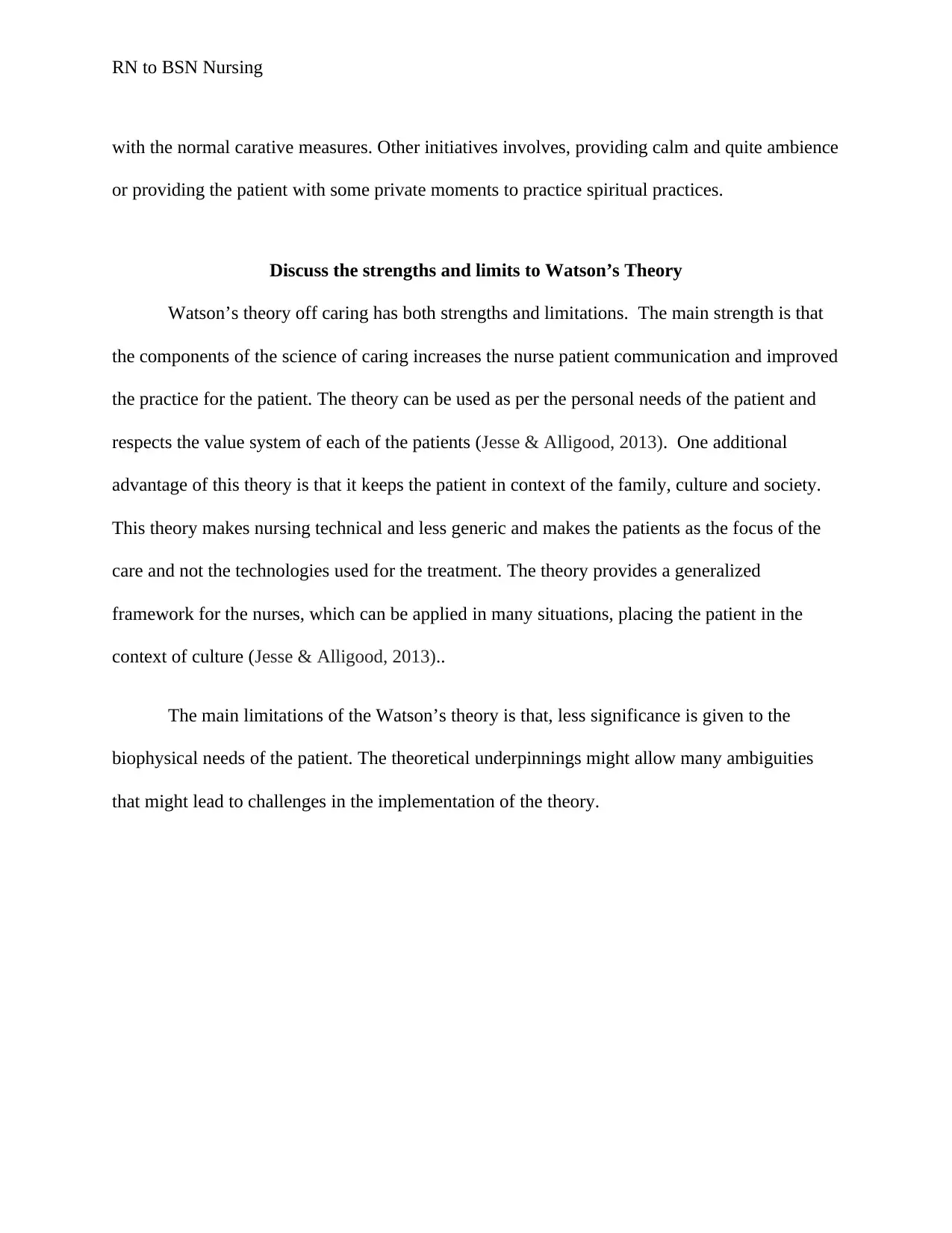
RN to BSN Nursing
with the normal carative measures. Other initiatives involves, providing calm and quite ambience
or providing the patient with some private moments to practice spiritual practices.
Discuss the strengths and limits to Watson’s Theory
Watson’s theory off caring has both strengths and limitations. The main strength is that
the components of the science of caring increases the nurse patient communication and improved
the practice for the patient. The theory can be used as per the personal needs of the patient and
respects the value system of each of the patients (Jesse & Alligood, 2013). One additional
advantage of this theory is that it keeps the patient in context of the family, culture and society.
This theory makes nursing technical and less generic and makes the patients as the focus of the
care and not the technologies used for the treatment. The theory provides a generalized
framework for the nurses, which can be applied in many situations, placing the patient in the
context of culture (Jesse & Alligood, 2013)..
The main limitations of the Watson’s theory is that, less significance is given to the
biophysical needs of the patient. The theoretical underpinnings might allow many ambiguities
that might lead to challenges in the implementation of the theory.
with the normal carative measures. Other initiatives involves, providing calm and quite ambience
or providing the patient with some private moments to practice spiritual practices.
Discuss the strengths and limits to Watson’s Theory
Watson’s theory off caring has both strengths and limitations. The main strength is that
the components of the science of caring increases the nurse patient communication and improved
the practice for the patient. The theory can be used as per the personal needs of the patient and
respects the value system of each of the patients (Jesse & Alligood, 2013). One additional
advantage of this theory is that it keeps the patient in context of the family, culture and society.
This theory makes nursing technical and less generic and makes the patients as the focus of the
care and not the technologies used for the treatment. The theory provides a generalized
framework for the nurses, which can be applied in many situations, placing the patient in the
context of culture (Jesse & Alligood, 2013)..
The main limitations of the Watson’s theory is that, less significance is given to the
biophysical needs of the patient. The theoretical underpinnings might allow many ambiguities
that might lead to challenges in the implementation of the theory.
Paraphrase This Document
Need a fresh take? Get an instant paraphrase of this document with our AI Paraphraser
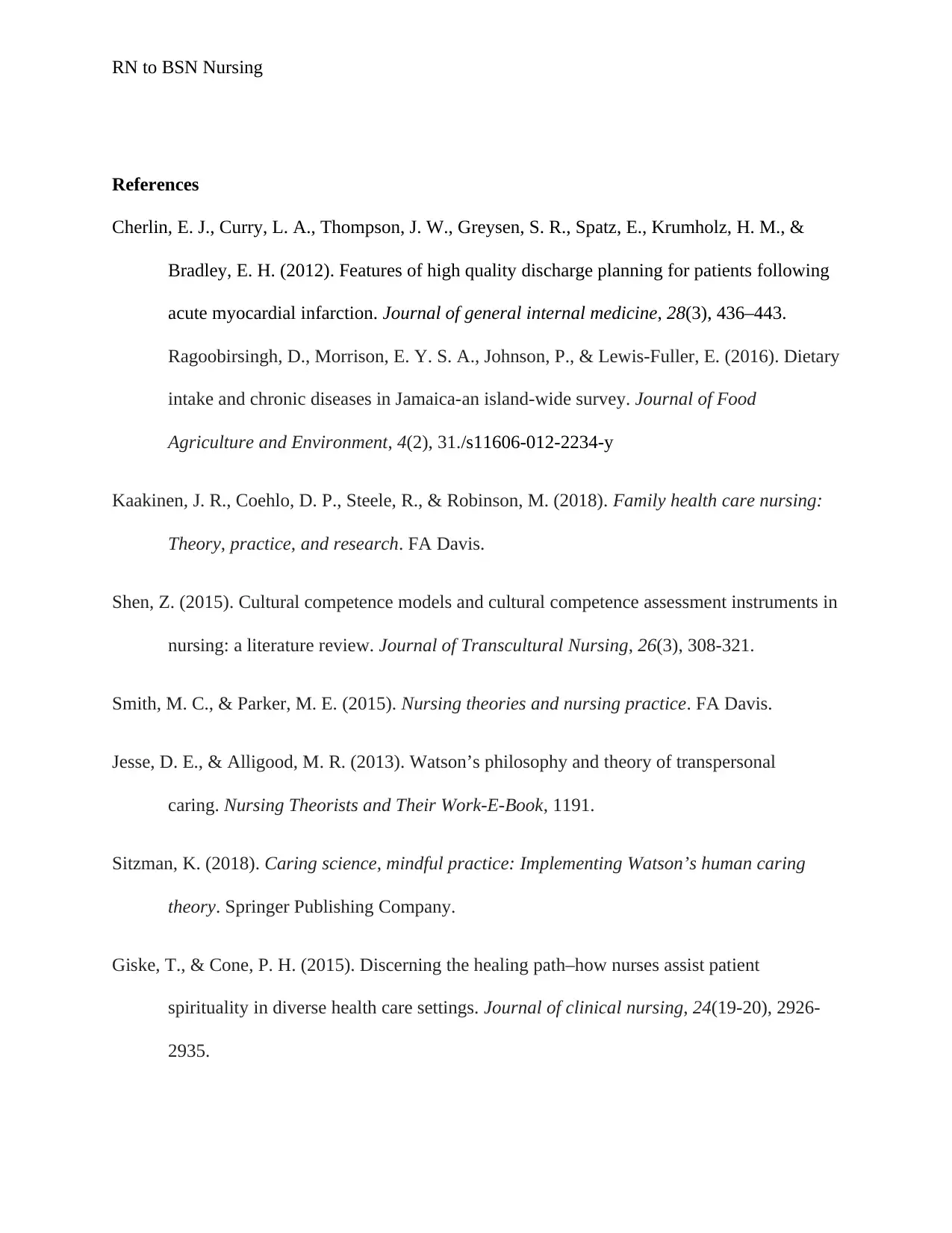
RN to BSN Nursing
References
Cherlin, E. J., Curry, L. A., Thompson, J. W., Greysen, S. R., Spatz, E., Krumholz, H. M., &
Bradley, E. H. (2012). Features of high quality discharge planning for patients following
acute myocardial infarction. Journal of general internal medicine, 28(3), 436–443.
Ragoobirsingh, D., Morrison, E. Y. S. A., Johnson, P., & Lewis-Fuller, E. (2016). Dietary
intake and chronic diseases in Jamaica-an island-wide survey. Journal of Food
Agriculture and Environment, 4(2), 31./s11606-012-2234-y
Kaakinen, J. R., Coehlo, D. P., Steele, R., & Robinson, M. (2018). Family health care nursing:
Theory, practice, and research. FA Davis.
Shen, Z. (2015). Cultural competence models and cultural competence assessment instruments in
nursing: a literature review. Journal of Transcultural Nursing, 26(3), 308-321.
Smith, M. C., & Parker, M. E. (2015). Nursing theories and nursing practice. FA Davis.
Jesse, D. E., & Alligood, M. R. (2013). Watson’s philosophy and theory of transpersonal
caring. Nursing Theorists and Their Work-E-Book, 1191.
Sitzman, K. (2018). Caring science, mindful practice: Implementing Watson’s human caring
theory. Springer Publishing Company.
Giske, T., & Cone, P. H. (2015). Discerning the healing path–how nurses assist patient
spirituality in diverse health care settings. Journal of clinical nursing, 24(19-20), 2926-
2935.
References
Cherlin, E. J., Curry, L. A., Thompson, J. W., Greysen, S. R., Spatz, E., Krumholz, H. M., &
Bradley, E. H. (2012). Features of high quality discharge planning for patients following
acute myocardial infarction. Journal of general internal medicine, 28(3), 436–443.
Ragoobirsingh, D., Morrison, E. Y. S. A., Johnson, P., & Lewis-Fuller, E. (2016). Dietary
intake and chronic diseases in Jamaica-an island-wide survey. Journal of Food
Agriculture and Environment, 4(2), 31./s11606-012-2234-y
Kaakinen, J. R., Coehlo, D. P., Steele, R., & Robinson, M. (2018). Family health care nursing:
Theory, practice, and research. FA Davis.
Shen, Z. (2015). Cultural competence models and cultural competence assessment instruments in
nursing: a literature review. Journal of Transcultural Nursing, 26(3), 308-321.
Smith, M. C., & Parker, M. E. (2015). Nursing theories and nursing practice. FA Davis.
Jesse, D. E., & Alligood, M. R. (2013). Watson’s philosophy and theory of transpersonal
caring. Nursing Theorists and Their Work-E-Book, 1191.
Sitzman, K. (2018). Caring science, mindful practice: Implementing Watson’s human caring
theory. Springer Publishing Company.
Giske, T., & Cone, P. H. (2015). Discerning the healing path–how nurses assist patient
spirituality in diverse health care settings. Journal of clinical nursing, 24(19-20), 2926-
2935.
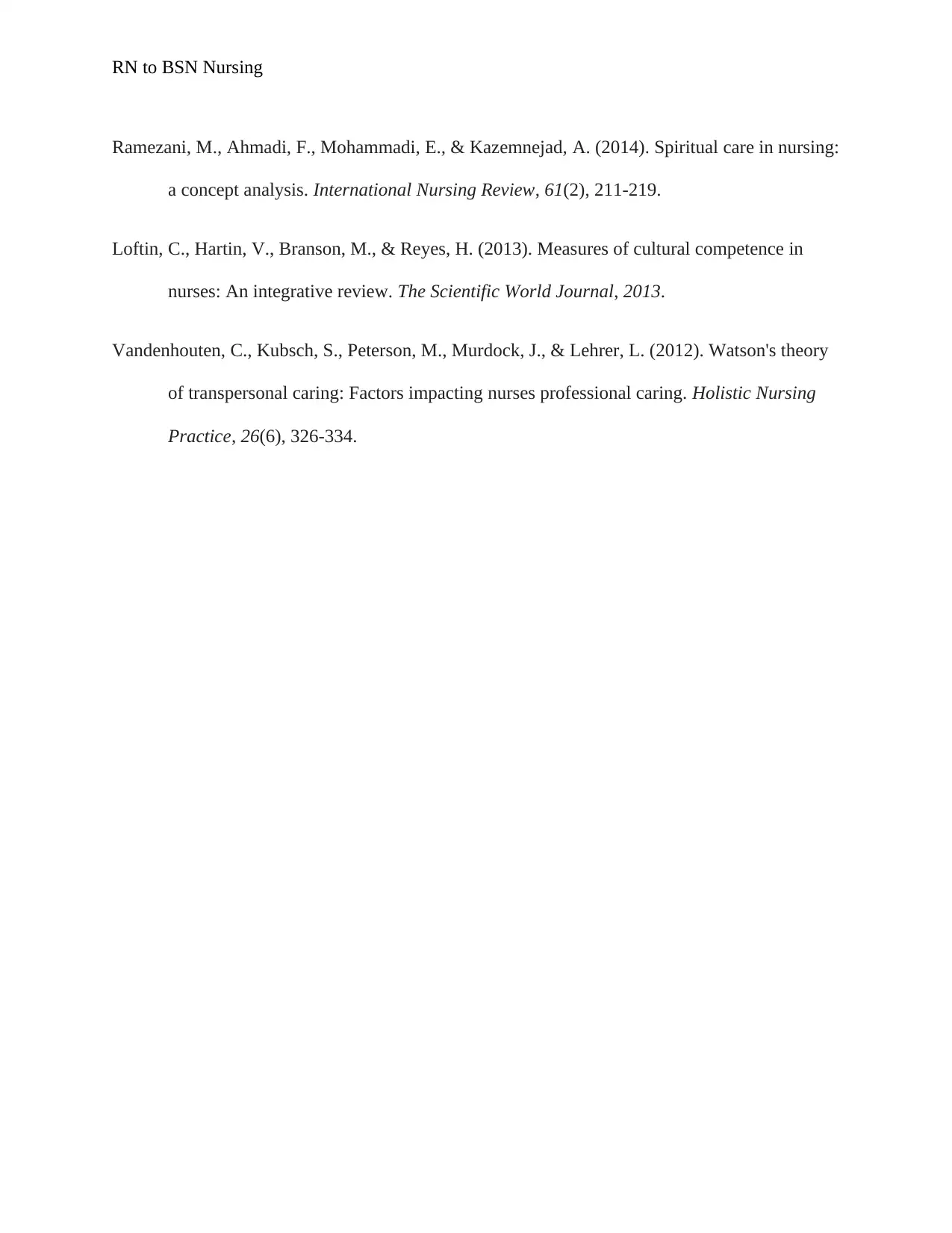
RN to BSN Nursing
Ramezani, M., Ahmadi, F., Mohammadi, E., & Kazemnejad, A. (2014). Spiritual care in nursing:
a concept analysis. International Nursing Review, 61(2), 211-219.
Loftin, C., Hartin, V., Branson, M., & Reyes, H. (2013). Measures of cultural competence in
nurses: An integrative review. The Scientific World Journal, 2013.
Vandenhouten, C., Kubsch, S., Peterson, M., Murdock, J., & Lehrer, L. (2012). Watson's theory
of transpersonal caring: Factors impacting nurses professional caring. Holistic Nursing
Practice, 26(6), 326-334.
Ramezani, M., Ahmadi, F., Mohammadi, E., & Kazemnejad, A. (2014). Spiritual care in nursing:
a concept analysis. International Nursing Review, 61(2), 211-219.
Loftin, C., Hartin, V., Branson, M., & Reyes, H. (2013). Measures of cultural competence in
nurses: An integrative review. The Scientific World Journal, 2013.
Vandenhouten, C., Kubsch, S., Peterson, M., Murdock, J., & Lehrer, L. (2012). Watson's theory
of transpersonal caring: Factors impacting nurses professional caring. Holistic Nursing
Practice, 26(6), 326-334.
⊘ This is a preview!⊘
Do you want full access?
Subscribe today to unlock all pages.

Trusted by 1+ million students worldwide
1 out of 9
Related Documents
Your All-in-One AI-Powered Toolkit for Academic Success.
+13062052269
info@desklib.com
Available 24*7 on WhatsApp / Email
![[object Object]](/_next/static/media/star-bottom.7253800d.svg)
Unlock your academic potential
Copyright © 2020–2025 A2Z Services. All Rights Reserved. Developed and managed by ZUCOL.




